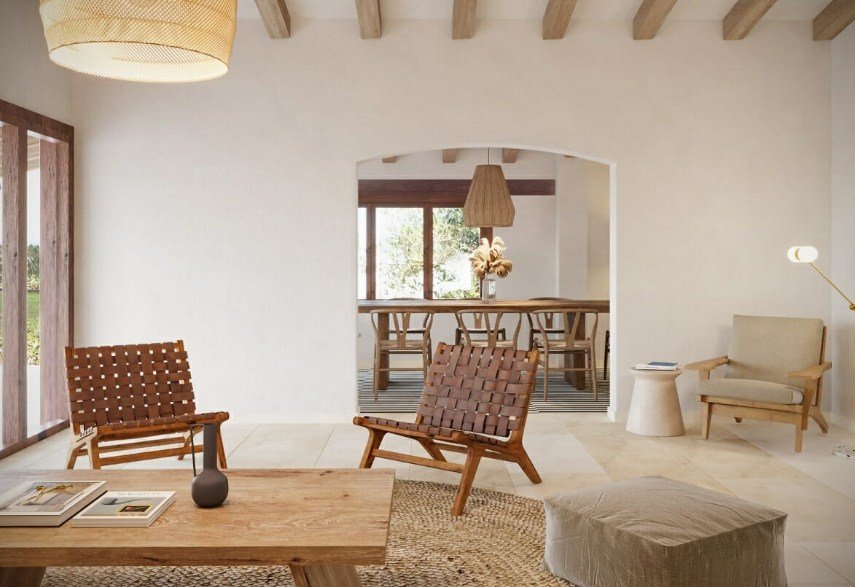Jim Willenborg, an Atlanta-based interior designer, has recently shared his insights on how interior design can promote wellness. He explained how the physical environment can affect the mental, emotional, and physical health of the occupants, and offered some tips on how to create spaces that foster well-being.
The Benefits of Bringing Nature Indoors
One of Jim Willenborg’s key recommendations for promoting wellness through interior design is the incorporation of natural elements. He noted that, bringing nature indoors can have a soothing and revitalizing effect. In his view, integrating elements such as indoor plants, natural materials, and ample natural light can help homeowners create an environment that promotes relaxation and reduces stress. He cited studies showing that exposure to nature, even in a domestic setting, can lead to increased productivity, improved mood, and decreased anxiety.
Some of the ways to bring nature indoors include:
- Using plants as decor items or creating a green wall
- Choosing natural materials such as wood, stone, or bamboo for flooring, furniture, or accessories
- Installing large windows or skylights to let in natural light and views
- Adding water features such as fountains or aquariums to create a soothing sound and visual effect
- Using natural colors such as green, blue, or brown to create a calming atmosphere
The Importance of Creating Spaces that Encourage Movement
Another aspect of interior design that can have a significant impact on wellness is the creation of spaces that encourage movement and physical activity. Jim Willenborg stated that, “A well-designed layout should facilitate easy movement and flow. Incorporating open spaces, ergonomic furniture, and functional layouts can motivate occupants to engage in more physical activity, ultimately contributing to better physical health.”
Jim Willenborg suggested considering adaptable furniture that allows for both sitting and standing positions, as well as incorporating designated areas for exercise or stretching. He also advised to avoid clutter and unnecessary items that can obstruct movement or create hazards.
Some of the benefits of creating spaces that encourage movement include:
- Improving blood circulation and oxygen delivery to the brain and muscles
- Reducing the risk of chronic diseases such as diabetes, heart disease, or obesity
- Enhancing mood and cognitive function by releasing endorphins and neurotransmitters
- Strengthening muscles and bones by preventing atrophy and osteoporosis
- Increasing flexibility and balance by preventing stiffness and injuries
The Role of Lighting in Regulating Circadian Rhythms
Lighting is another essential aspect of interior design that can have a substantial impact on wellness. Jim Willenborg recommended a combination of natural and artificial lighting sources that mimic the natural progression of light throughout the day. In his view, “Proper lighting not only enhances visibility but also regulates our circadian rhythms. Warm, soft lighting in the evening can promote relaxation, while brighter, cooler lighting during the day can boost energy and focus.”
Jim Willenborg also suggested using dimmers, timers, or smart devices to control the intensity and color temperature of the lighting according to the time of day and the activity. He also advised to avoid exposure to blue light from screens or devices before bedtime, as it can disrupt the production of melatonin and affect sleep quality.
Some of the benefits of lighting that regulates circadian rhythms include:
- Improving sleep quality and quantity by aligning with the natural sleep-wake cycle
- Reducing the risk of depression, anxiety, or mood disorders by influencing serotonin levels
- Enhancing immune system function by affecting cortisol levels
- Supporting metabolism and digestion by affecting hunger hormones
- Boosting creativity and productivity by affecting brain waves
The Influence of Personalization on Emotional Well-being
Jim Willenborg also emphasized the importance of creating spaces that foster mental and emotional well-being. He noted that, “a clutter-free environment can lead to a clutter-free mind. In his view, decluttering and organizing spaces can create a sense of calm and reduce feelings of overwhelm. Additionally, Jim stated that, incorporating elements of personalization, such as meaningful artwork or sentimental decor, can enhance emotional connections to the space.”
Jim Willenborg also advised to use colors, textures, patterns, or aromas that evoke positive emotions or memories. He also recommended creating zones for different purposes or moods, such as a cozy reading nook, a serene meditation corner, or a lively entertainment area.
Some of the benefits of personalization on emotional well-being include:
- Increasing self-esteem and confidence by expressing one’s identity and preferences
- Reducing stress and anxiety by creating a sense of comfort and familiarity
- Enhancing happiness and satisfaction by reflecting one’s values and goals
- Fostering social relationships by inviting guests or sharing stories
- Stimulating curiosity and learning by displaying books or collections
The Application of Wellness-Focused Design Beyond Residential Spaces
Jim Willenborg also believes that the concept of wellness-focused design extends beyond the residential sphere. He stated that, “Interior design can also promote wellness in commercial spaces such as offices, hotels, restaurants, or retail stores. By creating environments that support the health and well-being of the employees, customers, or guests, interior design can also enhance the performance and profitability of the businesses.”
Jim Willenborg cited examples of wellness-focused design in commercial spaces, such as:
- Using biophilic design to create a connection with nature and reduce stress
- Providing ergonomic furniture and equipment to improve comfort and productivity
- Incorporating natural lighting and ventilation to improve air quality and energy efficiency
- Using colors and branding to create a positive and memorable impression
- Creating spaces that facilitate collaboration, communication, or innovation
Jim Willenborg is an interior designer with over 20 years of experience in the industry. He specializes in creating spaces that are functional, beautiful, and wellness-oriented. He has worked on projects ranging from residential to commercial, from traditional to contemporary, from small to large. He is passionate about helping his clients achieve their vision and goals through interior design.

